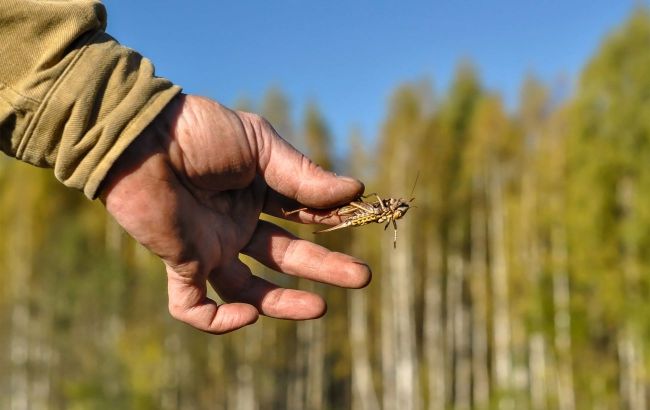Locust invasion in Ukraine: What's a real cause — war or weather?
 Ukraine is being attacked by locusts (photo: Getty Images)
Ukraine is being attacked by locusts (photo: Getty Images)
What is the current situation with the locust invasion in Ukraine, how much damage has it caused to the crops, and whether farmers will be able to receive compensation, as well as the risks of the pest attacking Kyiv and the western regions — all in an interview with RBC-Ukraine.
Key questions
-
Consequences of Russia’s ecocide: why is Ukraine suffering from locusts?
-
Locusts attacking Ukraine: what is the current situation in different regions?
-
Fight and control: do we have enough resources to eliminate the pest?
-
Threats to the harvest: will the fields survive the locust invasion?
-
Next targets: Kyiv, central, and western Ukraine — will locusts attack new regions?
-
Combating the pest: what to do if you find locusts in your garden?
In mid-July, the State Service of Ukraine on Food Safety and Consumer Protection recorded a massive locust migration in Zaporizhzhia. Within just a few days, the pest spread across nearly 3,000 hectares in the region, and then moved on to neighboring regions — Dnipropetrovsk, Odesa, and Kherson.
Locusts are particularly dangerous to cereal crops such as corn, millet, and wheat. A thousand locusts per square meter can destroy up to 30 kilograms of greenery, and swarms can travel up to 300 kilometers per day.
RBC-Ukraine interviewed Vadym Chaikovskyi, Deputy Head of the State Service of Ukraine on Food Safety and Consumer Protection, about the origin of the locust invasion in Ukraine, how controlled the situation is currently, and whether the pest threatens other regions.
Consequences of Russia’s ecocide: Why is Ukraine suffering from locusts?
– Mr. Vadym, how do you assess the current situation regarding the spread of locusts in Ukraine?
– Locust outbreaks occur annually in Ukraine — both this year and last year. The causes are a combination of factors that have become even more relevant now: rising average daily temperatures, changes in natural and climatic conditions, and other objective reasons. However, the most significant factor is the war.
The war has led to the neglect of lands near the contact line, as well as ecological consequences, including the destruction of the Kakhovka Hydroelectric Power Plant. This has created favorable conditions for locust reproduction.
The locust invasion is one of the consequences of the ecocide carried out by Russia against Ukraine and, in fact, against the entire world. It is worth noting that between 2022 and 2025, locust outbreaks were recorded specifically in the regions of active combat.
For example, in 2024, a special plant protection regime was introduced in the Slobozhanska settlement council of Chuhuiv district, Kharkiv region. In 2023, locust breeding sites were registered in the Donetsk, Zaporizhzhia, and Kherson regions, although the outbreaks there were less extensive.
For comparison, in 2010–2011, locust outbreaks occurred in the Odesa, Mykolaiv, and Dnipropetrovsk regions, when migrating locusts actively spread to neighboring areas.

Vadym Chaikovskyi, Deputy Head of the State Service of Ukraine on Food Safety and Consumer Protection (photo: dpss.gov.ua)
Natural enemies of locusts are birds; however, near the frontline, their numbers are almost nonexistent due to explosions and shelling that force them to leave these areas. Locusts, on the other hand, are not afraid of the shelling and continue to actively reproduce and spread across the regions.
Unfortunately, as long as the war continues, we cannot completely eliminate the threat of repeated locust outbreaks.
I would also like to note separately that the situation is currently under control. The locusts that were in Zaporizhzhia have, due to the southwesterly wind, migrated to temporarily occupied territories. We are monitoring the situation closely.
– How significant was the impact of the Kakhovka Hydroelectric Power Plant (HPP) destruction on the locust invasion?
– The intensive development of locusts in the southern regions of Ukraine is a result of the ecocide committed by Russia. In particular, due to the destruction of the Kakhovka HPP and the reduction of the Dnipro River’s flow in the southern regions, the number of neglected and uncultivable lands has increased, creating a favorable environment for locust reproduction. This especially concerns mined territories, where it is impossible for civilian specialists to carry out pest control measures.
The favorite breeding grounds for locusts remain riverbanks and abandoned plots, which unfortunately have become significantly more numerous today.
Additionally, in 2025, climate change had a substantial impact on locust reproduction, particularly in the southern regions of Ukraine, including the temporarily occupied territories of the Zaporizhzhia region.
Locusts attacking Ukraine: What is the current situation across the regions?
– Which areas are currently in the worst condition? Are there any new regions where active spread has been recorded?
– The locust situation is currently under control and not considered critical:
-
Zaporizhzhia region – This is where the most widespread pest hotspots have been recorded. The locusts have migrated to temporarily occupied territories. Active containment and elimination measures are ongoing.
-
Dnipropetrovsk region – Specialists visited suspected outbreak sites. Locust presence has indeed been confirmed, but only in small numbers. There is currently no threat of further spread.
-
Odesa region – Locusts have been detected here as well, though in moderate numbers. All affected areas have already been treated, so there was no need to introduce a special plant protection regime.
-
Kherson region – An outbreak occurred early in the season, but the situation was quickly brought under control. The special plant protection regime has now been lifted.
Experts from the State Service on Food Safety and Consumer Protection continue to monitor and respond promptly in all regions where there is a potential risk of pest spread.
– Do you foresee a threat to the 2025 harvest? Which crops are most at risk?
– According to available data, no significant losses to the agricultural sector caused by locusts have been recorded in 2025. The pest’s main food sources are concentrated mostly in floodplains near shelterbelts, ravines, and marshy areas.

The spread of locusts was triggered by ecocide caused by Russia, in particular the Kakhovka disaster (photo: Getty Images)
Fight and control: Do we have enough resources to eliminate the pest?
– Do the regions have enough resources to respond to such invasions? What kind of support does the state provide?
– The situation is under control. Monitoring and response to locust outbreaks are being overseen by local authorities and relevant services.
When outbreaks are identified, both local government bodies and specialists from the district offices of the State Service of Ukraine on Food Safety and Consumer Protection are involved in elimination efforts. Ukrainian agricultural producers, who possess the necessary equipment and resources for treatment, are also actively participating.
– Is compensation for losses available to farmers affected by the invasion?
– Direct compensation for losses caused by locust outbreaks is not currently provided for under Ukrainian legislation. The task of the State Service, local authorities, and other agencies is to prevent the large-scale spread of locusts and the associated damage. Frankly and transparently, the results of our efforts already show that we are succeeding.
– What should farmers do if they spot locusts in their fields?
If farmers notice locusts in their fields, there is no need to panic, especially if it's just a few individuals. The main thing is to promptly inform local offices of the State Service so they can respond quickly and carry out inspections. Early detection of an outbreak allows for timely containment and helps prevent the pest from spreading on a larger scale.
Kyiv, central and western Ukraine next? Will locusts spread to new regions?
– Last week, residents of Kyiv and the Bucha (city in the Kyiv region - ed.) district reported spotting the first locusts in the area. Is there any official confirmation of this?
– At this time, we have no data confirming the presence of locust outbreaks in these regions. We urge people not to spread unverified information and to rely on official sources. If locusts are detected, we recommend immediately informing local authorities for a prompt response.
– How serious is the risk for Kyiv?
– The risk of locusts spreading into Kyiv is currently considered low. Weather conditions and the urban landscape are not favorable for large-scale pest reproduction, especially given the significant rainfall in recent days.
At the same time, we are closely monitoring the situation to respond quickly if outbreaks are detected. The key is not to ignore even isolated cases and to report them to the appropriate services in a timely manner.
– Is there a risk of locusts reaching central or western Ukraine? What scenarios do you consider most likely?
– There is a risk of locusts reaching central and western regions of Ukraine, but it remains moderate. Locusts typically spread toward the south and east, where the climate is more suitable for them.
Widespread migration to central and western Ukraine would only be possible in the event of significant warming and prolonged drought, which would create a favorable environment for locusts. But according to the current weather forecast, this scenario appears unlikely.

Widespread locust migration to central and western Ukraine is only possible in the event of significant warming and prolonged drought (illustrative photo: Getty Images)
– And what happens in the worst-case scenario?
– While the worst-case scenario would certainly present serious challenges, I want to reassure everyone that the situation is fully under control. We have clear mechanisms in place for monitoring, coordination, and rapid response, along with strong support from local authorities and farmers.
Thanks to this, we are able to detect locust hotspots in time and prevent their spread, minimizing risks to crops and the economy. So there’s no reason to panic — our specialists are working around the clock to protect both agriculture and the population.
– Could locusts become a regular occurrence in Ukraine in the future?
– The weather conditions this season have created an ideal environment for locusts: moisture for larvae, warmth for a fast development cycle, and heat that encourages active migration. In coastal areas, locusts can form dense local clusters that, with further warming, could develop into threatening swarms.
Without proper monitoring and due to limited access to temporarily occupied territories, these hotspots could spread to neighboring regions.
– What steps are being taken to prevent a repeat of this situation next year? Is there a plan to establish an early warning system?
– At the moment, we are mostly seeing unverified information spreading on social media that does not reflect the actual situation.
We are actively working on monitoring, rapid response, and engaging local farmers in pest control. All necessary measures to protect agriculture have already been implemented, so there is no cause for concern.
The State Service on Food Safety and Consumer Protection is conducting continuous monitoring of locust hotspots in Ukrainian-controlled areas. We're operating under wartime conditions, so cooperation with other government agencies and local authorities is a top priority for us.
Only by joining forces can we overcome all challenges. Together we are strong — and that strength allows us to detect and localize pest outbreaks quickly, protect agriculture, and minimize risks to the harvest.

